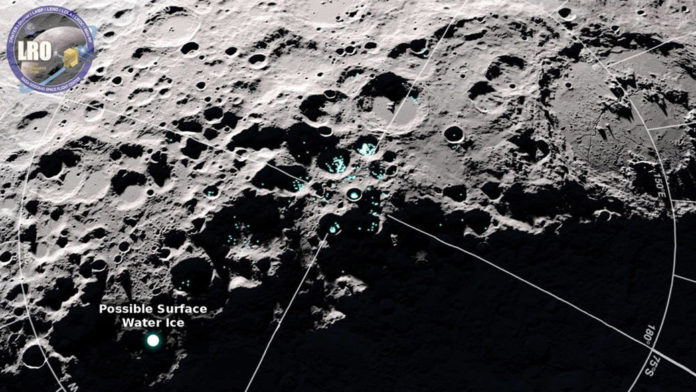Earth’s Moon was once assumed to be a dry and dusty place, but over time that image has changed. But the Moon isn’t nearly as dry as once thought. More recently, scientists have detected water molecules on Moon using data from NASA’s Lunar Reconnaissance Orbiter. They also identified the behavior of the moisture over the course of a lunar day.
Using an instrument aboard NASA’s LRO, scientists witnessed water molecules shifting around the dayside of the moon.
The surface water identified in sparse populations of molecules bound to the lunar soil, or regolith. The amount and locations vary based on the time of day. This water is more common at higher latitudes and tends to hop around as the surface heats up.
Dr. Kurt Retherford, the principal investigator of the LAMP instrument from Southwest Research Institute in San Antonio, Texas said, “This is an important new result about lunar water, a hot topic as our nation’s space program returns to a focus on lunar exploration. We recently converted the LAMP’s light collection mode to measure reflected signals on the lunar dayside with more precision, allowing us to track more accurately where the water is and how much is present.”
Scientists explained how Lyman Alpha Mapping Project (LAMP) measurements of the layer of molecules temporarily stuck to the surface helped determine the moon’s lunar hydration changes.
Amanda Hendrix, a Planetary Science Institute senior scientist and lead author of the paper, said in the press release said, “These results aid in understanding the lunar water cycle and will ultimately help us learn about the accessibility of water that can be used by humans in future missions to the moon. Lunar water can potentially be used by humans to make fuel or to use for radiation shielding or thermal management; if these materials do not need to be launched from Earth, that makes these future missions more affordable.”
Here’s how these water molecules work: They remain bound to the regolith until lunar noon when the moon’s surface temperatures tend to peak. Next, the water molecules thermally desorb and can “hop” to a nearby location that is cold enough for the molecules to stick to the moon’s weak atmosphere, until temperatures decrease and the molecules return to the moon’s surface.
Scientists have hypothesized that hydrogen ions in the solar wind may be the source of most of the Moon’s surface water. With that in mind, when the Moon passes behind the Earth and is shielded from the solar wind, the “water spigot” should essentially turn off. However, the water observed by LAMP does not decrease when the Moon is shielded by the Earth and the region influenced by its magnetic field, suggesting water builds up over time, rather than “raining” down directly from the solar wind.
John Keller, LRO deputy project scientist from NASA’s Goddard Space Flight Center in Greenbelt, Maryland said, “This result is an important step in advancing the water story on the Moon and is a result of years of accumulated data from the LRO mission.”
The findings are published in the Geophysical Research Letters.
